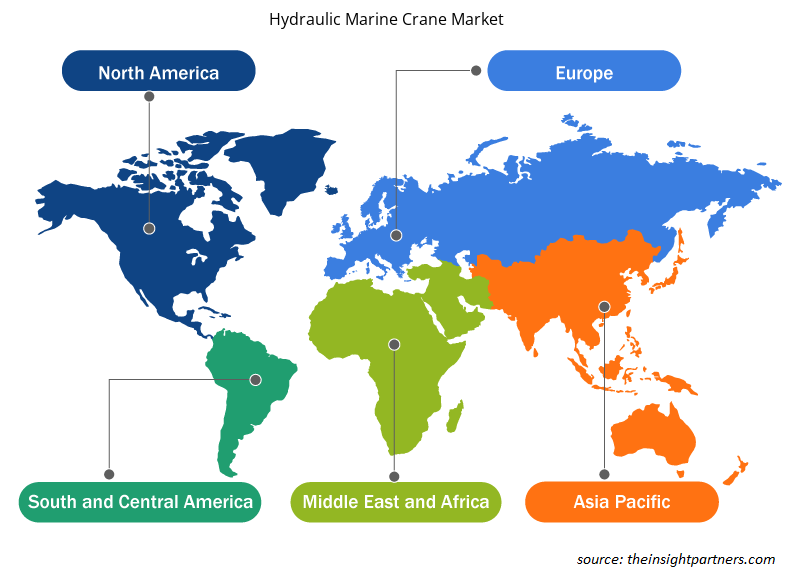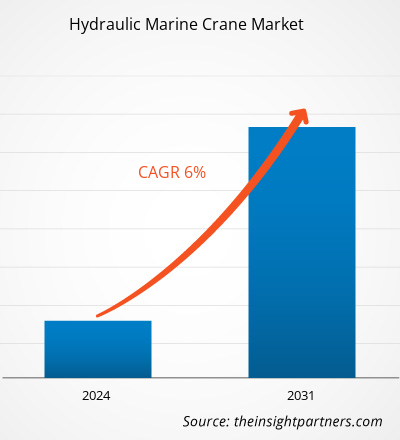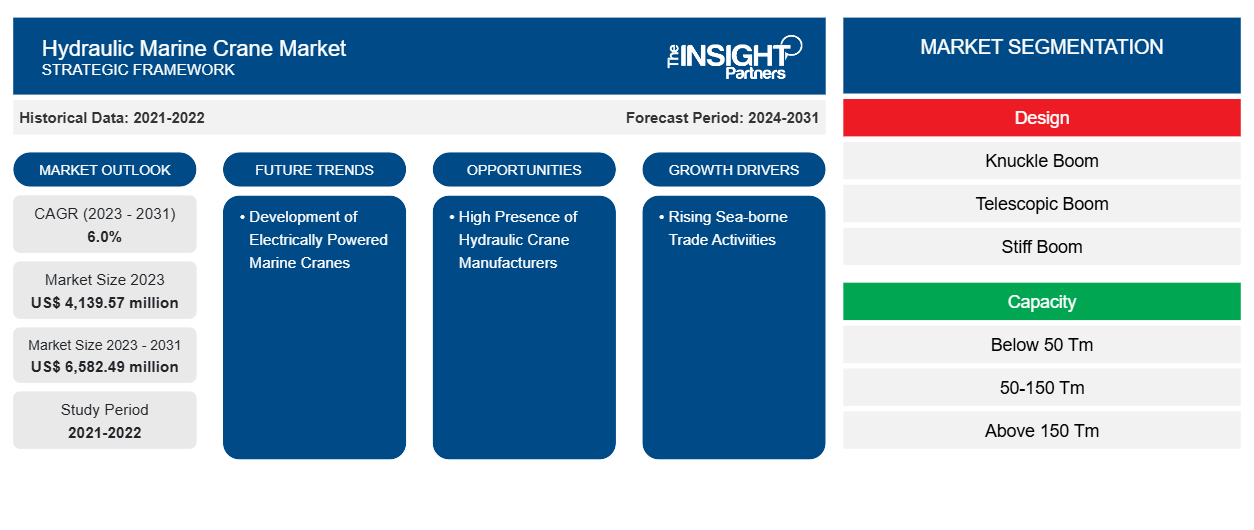Der Markt für hydraulische Schiffskräne soll von 4.139,57 Millionen US-Dollar im Jahr 2023 auf 6.582,49 Millionen US-Dollar im Jahr 2031 anwachsen. Der Markt wird zwischen 2023 und 2031 voraussichtlich eine durchschnittliche jährliche Wachstumsrate (CAGR) von 6,0 % verzeichnen. Die wachsende Zahl der seegestützten Handelsaktivitäten und der zunehmende Fokus der Regierung auf die Entwicklung der Meeresinfrastruktur werden voraussichtlich weiterhin ein wichtiger Trend auf dem Markt bleiben.
Hydraulische Schiffskräne Marktanalyse
Mehrere staatliche Investitionen in den Aufbau der maritimen Infrastruktur haben die Nachfrage nach hydraulischen Schiffskränen erhöht. Eine große Anzahl von Schiffsherstellern würde direkt zu einer erhöhten Nachfrage nach hydraulischen Schiffskränen weltweit führen. In den entwickelten Regionen wie Nordamerika und Europa gibt es führende Schiffskranhersteller wie die DMW Marine Group und Fred Wahl Marine Construction, Inc., die Schiffskräne mit Knickarm, Teleskopausleger und starrem Ausleger anbieten. All dies wird das Wachstum des Marktes für hydraulische Schiffskräne steigern.
Marktübersicht für hydraulische Schiffskrane
Die zunehmenden technologischen Entwicklungen ermöglichen es den Arbeitnehmern, flexibel zu bleiben. Die Integration fortschrittlicher Technologie in Schiffe und mehrere Offshore-Projekte würde das Wachstum des Marktes für hydraulische Schiffskräne weltweit vorantreiben. Länder wie Saudi-Arabien beschaffen sich Seetransportflotten, die den Einsatz fortschrittlicher Technologien in mehreren Schiffen, wie Frachtschiffen und Kriegsschiffen, fördern würden. Für die Implementierung und den Bau neuer technologischer Infrastrukturen wären Schiffskräne erforderlich, was die Nachfrage nach hydraulischen Schiffskränen steuert.
Passen Sie diesen Bericht Ihren Anforderungen an
Sie erhalten kostenlos individuelle Anpassungen an jedem Bericht, einschließlich Teilen dieses Berichts oder einer Analyse auf Länderebene, eines Excel-Datenpakets sowie tolle Angebote und Rabatte für Start-ups und Universitäten.
-
Holen Sie sich die wichtigsten Markttrends aus diesem Bericht.Dieses KOSTENLOSE Beispiel umfasst eine Datenanalyse von Markttrends bis hin zu Schätzungen und Prognosen.
Markttreiber und Chancen für hydraulische Schiffskrane
Wachsende Seehandelsaktivitäten begünstigen den Markt
Regierungsrichtlinien und -vorschriften zugunsten internationaler Handelsaktivitäten ziehen ausländische Investitionen an. Außerdem konzentrieren sich mehrere Regierungen auf die Entwicklung der Schifffahrtsindustrie und ziehen ausländische Direktinvestitionen in diesem Sektor an, was die Handelsaktivitäten auf dem Seeweg steigert und den Markt für Hydraulikkräne positiv beeinflusst. Die wachsenden technologischen Entwicklungsprojekte, die in Häfen und im Schiffsbau durchgeführt werden, wirken sich positiv auf die Handelsaktivitäten aus. Die wachsende Zahl der Handelsaktivitäten auf dem Seeweg erfordert eine angemessene Hafeninfrastruktur und Dockanlagen, um die große Anzahl an Handelsschiffen zu bedienen, die weltweit ein wichtiger Treiber für den Markt für Hydraulikkräne sind.FDI in this sector, which is increasing the sea-borne trading activities and influencing the hydraulic crane market positively. The growing technological development projects constructed across ports and in ship buildings are positively influencing trading activities. The growing number of sea-bourne trading activities require proper port infrastructure and dock facilities to cater to the large number of commercial ships, which is acting as a major driver for the hydraulic machine crane market globally.
Hohe Präsenz von Herstellern hydraulischer Kräne
Die Anzahl der Schiffskranhersteller in Regionen wie Europa, Asien-Pazifik und Nordamerika ist im Vergleich zu anderen Regionen hoch. Italien, China und die USA gehören zu den Ländern mit den größten Schiffskranherstellern. Die in diesen Regionen verfügbaren Schiffskrantypen sind Knickarm-, Teleskop- und Starrarm-Schiffskrane. Bei einer höheren Anzahl von Schiffskranherstellern wird daher ein positives Wachstum des Marktes erwartet. In den USA gibt es auch eine große Anzahl von Schiffsherstellern, was direkt zu einer erhöhten Nachfrage nach hydraulischen Schiffskranen führen würde.
Segmentierungsanalyse des Marktberichts für hydraulische Schiffskrane
Wichtige Segmente, die zur Ableitung der Marktanalyse für hydraulische Schiffskräne beigetragen haben, sind Design, Kapazität und Auslegerlänge.
- Basierend auf dem Design ist der Markt für hydraulische Schiffskräne in Knickarm-, Teleskop- , Starrarm- und Faltarmkräne unterteilt. Das Segment der Faltarmkräne hatte im Jahr 2023 einen größeren Marktanteil.
- Nach Kapazität ist der Markt in unter 50 Tm, 50-150 Tm und über 150 Tm segmentiert. Das Segment 50 – 150 Tm hielt im Jahr 2023 einen bedeutenden Marktanteil.
- Nach Auslegerlänge ist der Markt in unter 10 Meter, 10-20 Meter und über 20 Meter segmentiert. Das Segment unter 10 Metern hatte im Jahr 2023 einen erheblichen Marktanteil.
Hydraulische Schiffskran Marktanteilsanalyse nach Geografie
Der geografische Umfang des Marktberichts für hydraulische Schiffskräne ist hauptsächlich in fünf Regionen unterteilt: Nordamerika, Asien-Pazifik, Europa, Naher Osten und Afrika sowie Süd- und Mittelamerika.
Europa ist Marktführer. Hohe staatliche Investitionen in die Entwicklung der maritimen Infrastruktur haben die Nachfrage nach hydraulischen Schiffskränen in der Region positiv beeinflusst. Die wachsenden technologischen Entwicklungsprojekte in Häfen und im Schiffsbau erhöhen die Nachfrage nach hydraulischen Schiffskränen auf den europäischen Märkten. Europa ist eine wirtschaftlich fortschrittliche Region. Großbritannien, Spanien, Italien, Frankreich, Deutschland, die Schweiz, Russland, Schweden und die Niederlande sind einige der wichtigsten Länder in der Region. Die hohe Präsenz von Schiffbau- und Hydraulikkranherstellern wirkt sich ebenfalls positiv auf den Markt für hydraulische Schiffskräne in Europa aus.
Regionale Einblicke in den Markt für hydraulische Schiffskrane
Die regionalen Trends und Faktoren, die den Markt für hydraulische Schiffskrane im Prognosezeitraum beeinflussen, wurden von den Analysten von Insight Partners ausführlich erläutert. In diesem Abschnitt werden auch die Marktsegmente und die Geografie für hydraulische Schiffskrane in Nordamerika, Europa, im asiatisch-pazifischen Raum, im Nahen Osten und Afrika sowie in Süd- und Mittelamerika erörtert.

- Erhalten Sie regionale Daten zum Markt für hydraulische Schiffskrane
Umfang des Marktberichts für hydraulische Schiffskrane
| Berichtsattribut | Details |
|---|---|
| Marktgröße im Jahr 2023 | 4.139,57 Millionen US-Dollar |
| Marktgröße bis 2031 | 6.582,49 Millionen US-Dollar |
| Globale CAGR (2023 - 2031) | 6,0 % |
| Historische Daten | 2021-2022 |
| Prognosezeitraum | 2024–2031 |
| Abgedeckte Segmente |
Von Design
|
| Abgedeckte Regionen und Länder |
Nordamerika
|
| Marktführer und wichtige Unternehmensprofile |
|
Marktteilnehmerdichte: Der Einfluss auf die Geschäftsdynamik
Der Markt für hydraulische Schiffskrane wächst rasant, angetrieben durch die steigende Nachfrage der Endnutzer aufgrund von Faktoren wie sich entwickelnden Verbraucherpräferenzen, technologischen Fortschritten und einem größeren Bewusstsein für die Vorteile des Produkts. Mit steigender Nachfrage erweitern Unternehmen ihr Angebot, entwickeln Innovationen, um die Bedürfnisse der Verbraucher zu erfüllen, und nutzen neue Trends, was das Marktwachstum weiter ankurbelt.
Die Marktteilnehmerdichte bezieht sich auf die Verteilung der Firmen oder Unternehmen, die in einem bestimmten Markt oder einer bestimmten Branche tätig sind. Sie gibt an, wie viele Wettbewerber (Marktteilnehmer) in einem bestimmten Marktraum im Verhältnis zu seiner Größe oder seinem gesamten Marktwert präsent sind.
Die wichtigsten auf dem Markt für hydraulische Schiffskräne tätigen Unternehmen sind:
- Amco Veba Marine
- Dmw Marine Gruppe
- Fassi Gru SpA
- Fred Wahl Marine Construction, Inc.
- Heila Cranes SpA
- Hydrauliska Industri AB
Haftungsausschluss : Die oben aufgeführten Unternehmen sind nicht in einer bestimmten Reihenfolge aufgeführt.

- Überblick über die wichtigsten Akteure auf dem Markt für hydraulische Schiffskrane
Neuigkeiten und aktuelle Entwicklungen zum Markt für hydraulische Schiffskräne
Der Markt für hydraulische Schiffskrane wird durch die Erhebung qualitativer und quantitativer Daten nach Primär- und Sekundärforschung bewertet, die wichtige Unternehmensveröffentlichungen, Verbandsdaten und Datenbanken umfasst. Nachfolgend sind einige der Entwicklungen auf dem Markt für hydraulische Schiffskrane aufgeführt:
- Amco Veba Marine bringt 40tm Schiffskrane auf den Markt. (Quelle: Amco Veba Marine, Pressemitteilung, Mai 2022)
- Die Krankategorien V820NM und V823NM von Amco Veba Marine wurden von DNV nach der Norm DNV-ST-0377 für Schiffshebezeuge zertifiziert. (Quelle: Amco Veba Marine, Pressemitteilung, September 2022)
Marktbericht zu hydraulischen Schiffskränen – Umfang und Ergebnisse
Der Bericht „Marktgröße und Prognose für hydraulische Schiffskrane (2021–2031)“ bietet eine detaillierte Analyse des Marktes, die die folgenden Bereiche abdeckt:
- Marktgröße und Prognose für hydraulische Schiffskrane auf globaler, regionaler und Länderebene für alle wichtigen Marktsegmente, die im Rahmen des Berichts abgedeckt sind
- Markttrends für hydraulische Schiffskrane sowie Marktdynamik wie Treiber, Beschränkungen und wichtige Chancen
- Detaillierte PEST- und SWOT-Analyse
- Marktanalyse für hydraulische Schiffskrane mit Blick auf wichtige Markttrends, globale und regionale Rahmenbedingungen, wichtige Akteure, Vorschriften und aktuelle Marktentwicklungen
- Branchenlandschaft und Wettbewerbsanalyse, die die Marktkonzentration, Heatmap-Analyse, prominente Akteure und aktuelle Entwicklungen für den Markt für hydraulische Schiffskrane umfasst
- Detaillierte Firmenprofile
- Historische Analyse (2 Jahre), Basisjahr, Prognose (7 Jahre) mit CAGR
- PEST- und SWOT-Analyse
- Marktgröße Wert/Volumen – Global, Regional, Land
- Branchen- und Wettbewerbslandschaft
- Excel-Datensatz
Aktuelle Berichte
Verwandte Berichte
Erfahrungsberichte
Grund zum Kauf
- Fundierte Entscheidungsfindung
- Marktdynamik verstehen
- Wettbewerbsanalyse
- Kundeneinblicke
- Marktprognosen
- Risikominimierung
- Strategische Planung
- Investitionsbegründung
- Identifizierung neuer Märkte
- Verbesserung von Marketingstrategien
- Steigerung der Betriebseffizienz
- Anpassung an regulatorische Trends























 Kostenlose Probe anfordern für - Markt für hydraulische Schiffskrane
Kostenlose Probe anfordern für - Markt für hydraulische Schiffskrane